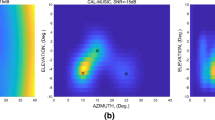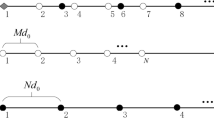Abstract
This paper deals with the problem of active calibration under the existence of sensor gain/phase uncertainties and position perturbations. Unlike many existing eigenstructure-based (also called subspace-based) calibration methods which using the spatial-domain (i.e., angle) information of the auxiliary sources only, our proposed approach enables exploitation of both the spatial- and time-domain knowledge of the sources, and therefore yields better performance than the eigenstructure-based calibration technology. For the purpose of incorporating the time-domain knowledge of the sources into the error calibration, the maximum likelihood criterion is selected as the optimization principle, and a concentrated alternating iteration procedure (called algorithm II) is developed, which has rapid convergence rate and robustness. As a byproduct of this paper, we also provide an eigenstructure-based calibration approach (termed algorithm I), which alternatively minimizes the weighted signal subspace fitting cost function and weighted noise subspace fitting criterion to update the estimates for sensor position perturbations and gain/phase errors in each iteration, respectively. Similar to some previous subspace-based calibration algorithms in the literature, algorithm I is also asymptotically efficient but is more computationally convenient, and can be introduced as benchmark to be compared to algorithm II. Additionally, the Cramér–Rao bound (CRB) expressions for the sensor gain/phase errors and position perturbations estimates are presented for two situations: (a) the time-domain waveform information of the sources is unavailable, and (b) the time-domain waveform information of the sources is taken as prior knowledge into account. The CRBs for the two cases are also quantitatively compared, and the resulting conclusion demonstrates that by combining the time-domain waveform information of the sources into the calibration algorithm, a significant performance improvement can be achieved. The simulation experiments are conducted to corroborate the advantages of the proposed algorithms as well as the theoretical analysis in this paper.










Similar content being viewed by others
Explore related subjects
Discover the latest articles, news and stories from top researchers in related subjects.References
Aktas, M., & Tuncer, T. E. (2010). Iterative HOS-SOS (IHOSS) algorithm for direction-of-arrival estimation and sensor localization. IEEE Transactions on Signal Processing, 58(12), 6181–6194.
Bao, Q., Ko, C. C., & Zhi, W. (2005). DOA estimation under unknown mutual coupling and multipath. IEEE Transactions on Aerospace and Electronic Systems, 41(2), 565–573.
Cheng, Q., Hua, Y. B., & Stoica, P. (2000). Asymptotic performance of optimal gain-and-phase estimators of sensor arrays. IEEE Transactions on Signal Processing, 48(12), 3587–3590.
Ferréol, A., Larzabal, P., & Viberg, M. (2006). On the asymptotic performance analysis of subspace DOA estimation in the presence of modeling errors: Case of MUSIC. IEEE Transactions on Signal Processing, 54(3), 907–920.
Ferréol, A., Larzabal, P., & Viberg, M. (2008). Performance prediction of maximum-likelihood direction-of-arrival estimation in the presence of modeling errors. IEEE Transactions on Signal Processing, 56(10), 4785–4793.
Ferréol, A., Larzabal, P., & Viberg, M. (2010). Statistical analysis of the MUSIC algorithm in the presence of modeling errors, taking into account the resolution probability. IEEE Transactions on Signal Processing, 58(8), 4156–4166.
Flanagan, B. P., & Bell, K. L. (2001). Array self-calibration with large sensor position errors. Signal Processing, 81(10), 2201–2214.
Jansson, M., Götansson, B., & Ottersten, B. (1999). A subspace method for direction of arrival estimation of uncorrelated emitter signals. IEEE Transactions on Signal Processing, 47(4), 945–956.
Jia, Y. K., Bao, Z., & Wu, H. (1996). A new calibration technique with signal sources for position, gain and phase uncertainty of sensor array. Acta Electronica Sinica, 24(3), 47–52.
Jiang, J. J., Duan, F. J., Chen, J., Chao, Z., Chang, Z. J., & Hua, X. N. (2013). Two new estimation algorithms for sensor gain and phase errors based on different data models. IEEE Sensors Journal, 13(5), 1921–1930.
Leshem, A., & Veen, A. J. (1999). Direction-of-arrival estimation for constant modulus signals. IEEE Transactions on Signal Processing, 47(11), 3125–3129.
Li, J., Halder, B., Stoica, P., & Viberg, M. (1995). Computationally efficient angle estimation for signals with known waveforms. IEEE Transactions on Signal Processing, 43(9), 2154–2163.
Li, Y. M., & Er, M. H. (2006). Theoretical analyses of gain and phase error calibration with optimal implementation for linear equispaced array. IEEE Transactions on Signal Processing, 54(2), 712–723.
Liu, A. F., Liao, G. S., Zeng, C., Yang, Z. W., & Xu, Q. (2011). An eigenstructure method for estimating DOA and sensor gain-phase errors. IEEE Transactions on Signal Processing, 59(12), 5944–5956.
Ng, B.C., Ser, W. (1992). Array shape calibration using sources in known locations. In: Proceedings of the ICCS/ISITA communications on the Moveapos. Singapore: IEEE Press, 1992, 2: 836–840.
Ng, B. C., & Nehorai, A. (1995). Active array sensor localization. Signal Processing, 44(3), 309–327.
Ottersten, B., Viberg, M., Stoica, P., Nehorai, A. (1993). Exact and large sample ML techniques for parameter estimation and detection in array processing. In: Haykin, Litva and Shepherd (Eds.) Radar array processing (pp. 99–151). Berlin: Springer.
Park, H. Y., Lee, C. Y., Kang, H. G., & Youn, D. H. (2004). Generalization of subspace-based array shape estimations. IEEE Journal of Oceanic Engineering, 29(3), 847–856.
See, C. M. S., & Poth, B. K. (1999). Parametric sensor array calibration using measured steering vectors of uncertain locations. IEEE Transactions on Signal Processing, 47(4), 1133–1137.
See, C. M. S., & Gershman, A. B. (2004). Direction-of-arrival estimation in partly calibrated subarray-based sensor arrays. IEEE Transactions on Signal Processing, 52(2), 329–338.
Soon, V. C., Tong, L., Huang, Y. F., & Liu, R. (1994). A subspace method for estimating sensor gains and phases. IEEE Transactions on Signal Processing, 42(4), 973–976.
Stoica, P., & Larsson, E. G. (2001). Comments on “Linearization method for finding Cramér–Rao bounds in signal processing”. IEEE Transactions on Signal Processing, 49(12), 3168–3169.
Viberg, M., & Swindlehurst, A. L. (1994). A Bayesian approach to auto-calibration for parametric array signal processing. IEEE Transactions on Signal Processing, 42(12), 3495–3507.
Vu, D. T., Renaux, A., Boyer, R., & Marcos, S. (2013). A cramér rao bounds based analysis of 3D antenna array geometries made from ULA branches. Multidimensional Systems and Signal Processing, 24, 121–155.
Wan, S., Chung, P. J., & Mulgrew, B. (2012). Maximum likelihood array calibration using particle swarm optimization. IET Signal Processing, 6(5), 456–465.
Wang, C. C., Cadzow, J. A. (1991). Direction-finding with sensor gain, phase and location uncertainty. In: Proceedings of the international conference on acoustics, speech and signal processing. Toronto, Ontario: IEEE Press, 1991, vol. 2, pp. 1429–1432.
Wang, D., & Wu, Y. (2008). Self-calibration algorithm for DOA estimation in presence of sensor amplitude, phase uncertainties and sensor position errors. Chinese Journal of Data Acquisition & Processing, 23(2), 176–181.
Wang, D., & Wu, Y. (2010). Array errors active calibration algorithm and its improvement. Science China Information Sciences, 53(5), 1016–1033.
Wang, D. (2013). Sensor array calibration in presence of mutual coupling and gain/phase errors by combining the spatial-domain and time-domain waveform information of the calibration sources. Circuits, Systems, and Signal Processing, 32(3), 1257–1292.
Weiss, A. J., & Friedlander, B. (1990). Eigenstructure methods for direction finding with sensor gain and phase uncertainties. Circuits Systems, Signal Processing, 9(2), 272–300.
Weiss, A. J., & Friedlander, B. (1991). Array shape calibration using eigenstructure methods. Signal Processing, 22(3), 251–258.
Weiss, A. J., & Friedlander, B. (1996). “Almost Blind” steering vector estimation using second-order moments. IEEE Transactions on Signal Processing, 44(4), 1024–1027.
Wijnholds, S. J., Boonstra, A. J. (2006). A multisource calibration method for phased array radio telescopes. In: Proceedings of 4th IEEE workshop on sensor array and multi-channel processing. Waltham, MA: IEEE Press, 2006, 200–204.
Wijnholds, S. J., & Veen, A. J. (2009). Multisource self-calibration for sensor arrays. IEEE Transactions on Signal Processing, 57(9), 3512–3522.
Zhang, X., Chen, C., Li, J., & Xu, D. (2014). Blind DOA and polarization estimation for polarization-sensitive array using dimension reduction MUSIC. Multidimensional Systems and Signal Processing, 25, 67–82.
Author information
Authors and Affiliations
Corresponding author
Appendices
Appendix 1: Proof of (31)–(35)
Applying the first-order derivation operator of the orthogonal projection matrix, it follows that
The substitution of (89) into (30) yields
which further implies that
Similarly, it follows that
Combining (91) and (92), equation (32) is proved to be true.
On the other hand, through some algebraic manipulations we can approximately obtain

which produces

It can be easily checked from (94) that
Likewise, it can be proved that
Combining (95)–(97), equality (33) holds true and hence the proof is completed.
Appendix 2: Proof of Lemma 1
To prove Lemma 1, we begin by supposing that there exits a nonzero real vector \({{\varvec{y}}}\) of conformable dimension satisfying
it follows that
which contradicts the assumption that \({{\varvec{X}}}_1 \ge {{\varvec{X}}}_2 \). Thus, Lemma 1 holds true.
Appendix 3: Proof of Lemma 2
Performing the singular value decomposition (SVD) on \({{\varvec{X}}}_1 \) leads to
where \({{\varvec{U}}}^{\mathrm{H}}{{\varvec{U}}}={{\varvec{I}}}\) such that \(\hbox {range}\left\{ {{{\varvec{X}}}_1 } \right\} =\hbox {range}\left\{ {{\varvec{U}}} \right\} \). Since \(\hbox {range}\left\{ {{{\varvec{X}}}_1 } \right\} \subseteq \hbox {range}\left\{ {{{\varvec{X}}}_2 } \right\} \), we can construct a orthogonal matrix \({\bar{{\varvec{U}}}}\) satisfying that \({\bar{{\varvec{U}}}}^{\mathrm{H}}{\bar{{\varvec{U}}}}={{\varvec{I}}}\), \({\bar{{\varvec{U}}}}^{\mathrm{H}}{{\varvec{U}}}={{\varvec{O}}}\) and \(\hbox {range}\left\{ {{{\varvec{X}}}_\mathrm{2} } \right\} =\hbox {range}\left\{ {\left[ {{\begin{array}{ll} {{\varvec{U}}}&{} {{\bar{{\varvec{U}}}}} \\ \end{array} }} \right] } \right\} \), which produces
It follows immediately from (101) that \(\Pi ^{\bot }\left[ {{{\varvec{X}}}_1 } \right] \ge \Pi ^{\bot }\left[ {{{\varvec{X}}}_\mathrm{2} } \right] \) and, therefore, Lemma 2 is proved.
Rights and permissions
About this article
Cite this article
Wang, D., Wu, Y. Sensor array calibration method in presence of gain/phase uncertainties and position perturbations using the spatial- and time-domain information of the auxiliary sources. Multidim Syst Sign Process 26, 835–868 (2015). https://doi.org/10.1007/s11045-014-0284-5
Received:
Revised:
Accepted:
Published:
Issue Date:
DOI: https://doi.org/10.1007/s11045-014-0284-5




